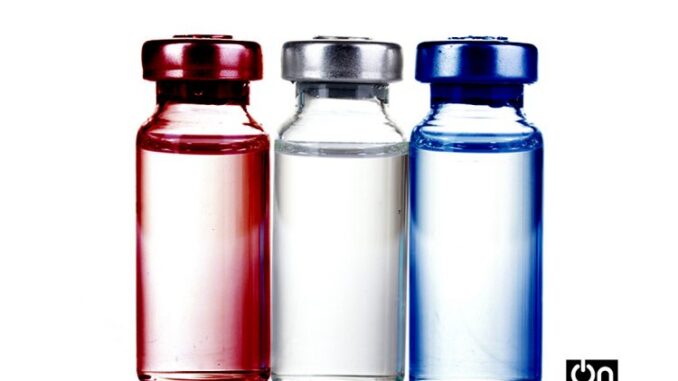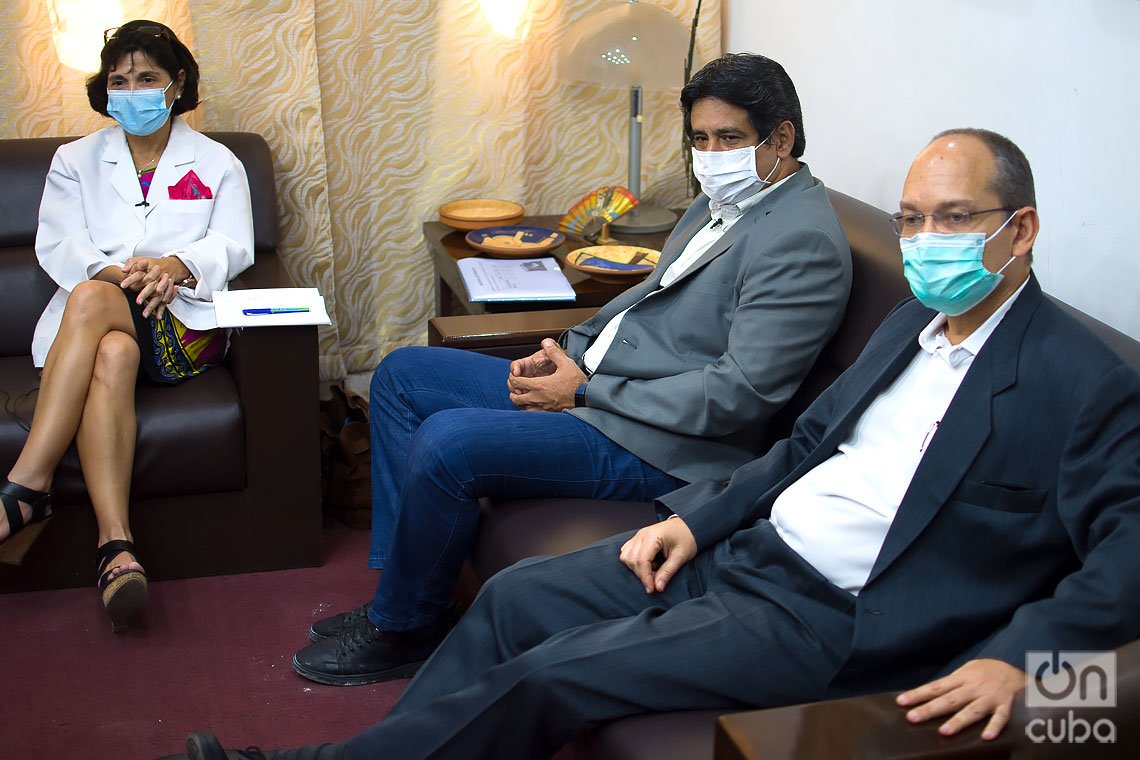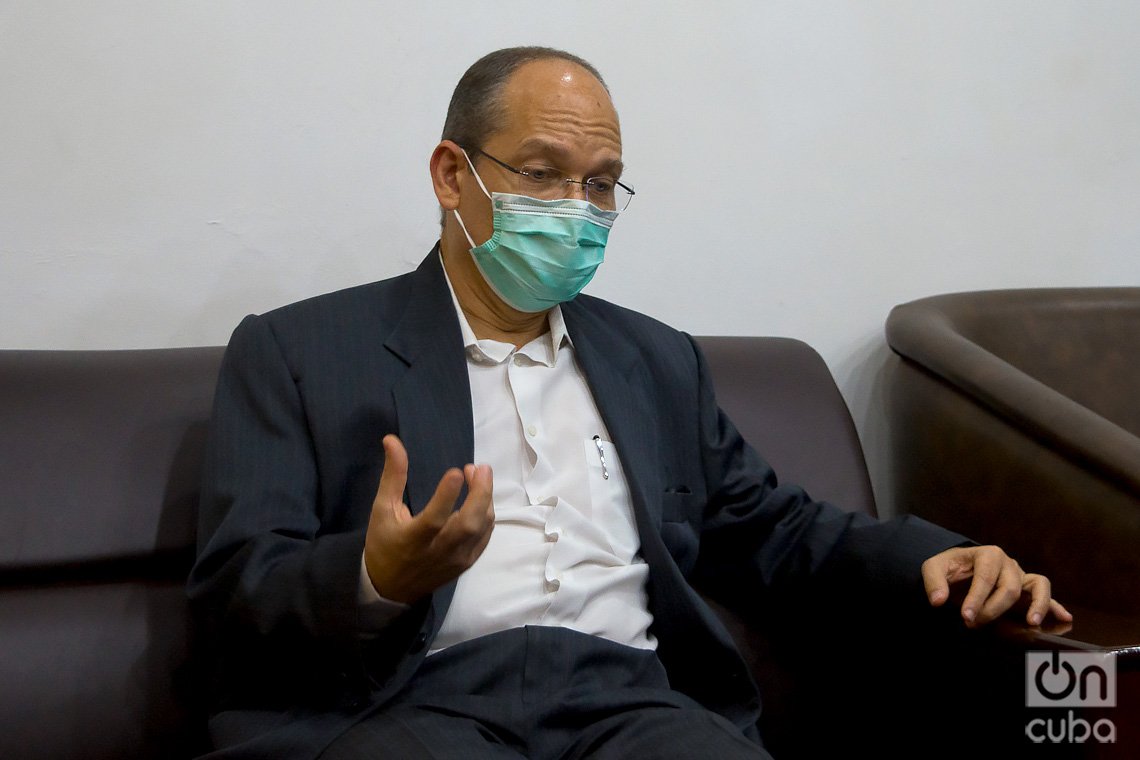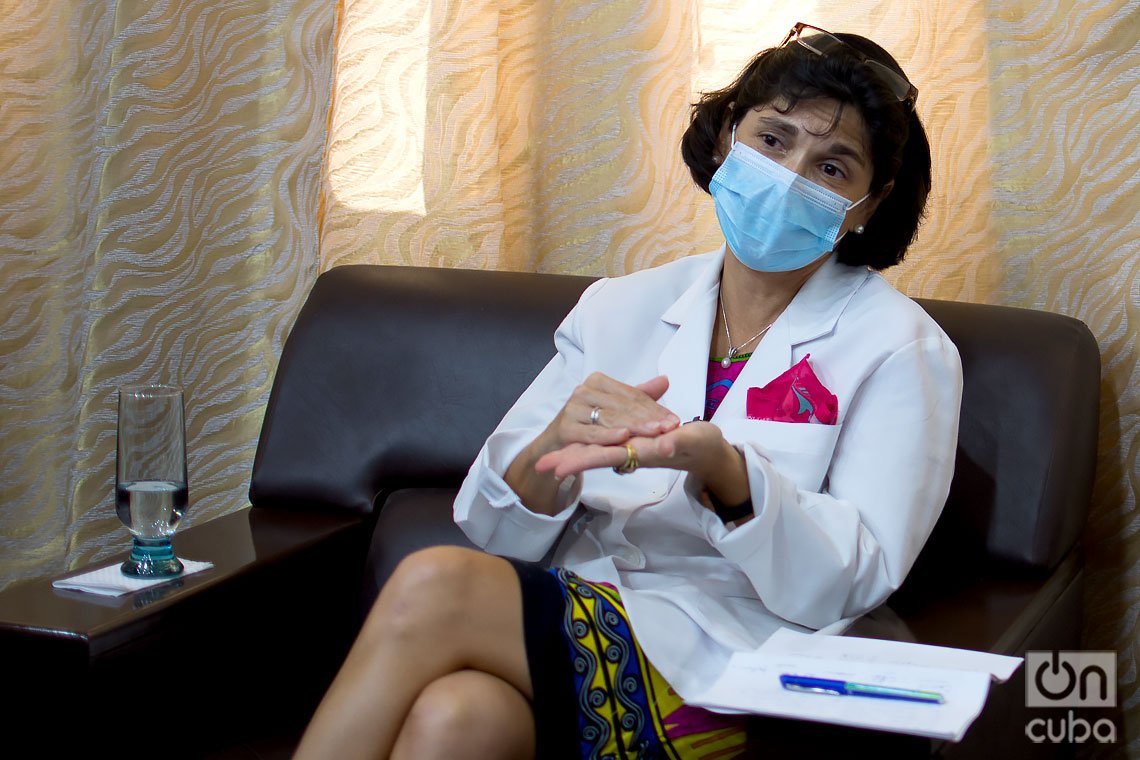
The biotechnology sector has been fundamental in Cuba’s successful battle against COVID-19. Thanks to a more than 30-year-old structured and recognized industry, the talent and dedication of its scientists, and the results obtained over decades, the island’s biotechnology has been able to quickly make available to hospitals a battery of products, converted by their effectiveness into pillars of the Cuban medical protocol against the pandemic.
The recombinant interferon alpha 2b, of proven antiviral efficacy, the monoclonal Itolizumab and the CIGB 258 peptide, the latter two used in the treatment of patients who reach the severe phases of the disease, have been key in reducing the mortality rate from COVID-19 in Cuba, which has remained below 4%. They are not, logically, the only medicines produced on the island now redirected as part of this battle for life, but they are bulwarks of that effort, the most visible fruits today of a leafy tree still growing and with many challenges ahead.
“There are 70 ongoing research protocols in Cuba related to COVID-19, which in these months have been approved by the joint scientific committee. It may be difficult for someone to believe, but it is so,” says Dr. Tania Crombet, director of clinical research at the Center for Molecular Immunology (CIM), in an exclusive interview with OnCuba. “While there have been products that have had more visibility, such as interferons with their well-earned fame, and the two molecules that are being used in seriously or critically ill patients, we have other drugs that we have also been using successfully and are continuing to investigate.”
“For example,” she specifies, “from our center there is another molecule that is already known, recombinant human erythropoietin, which is also part of the protocol for the seriously or critically ill patients. In this case, it is a molecule that is used for two purposes: it is known to have a role in improving oxygenation, and these are patients with hypoxia, and we also introduced it knowingly that it has a cytoprotective role. We wanted to know how to prevent damage induced by ischemia, by hypoxia in the lungs and in other organs such as the heart, kidneys, liver; therefore, Cuban patients have the opportunity of getting another very expensive medicine from the biotechnological industry as part of the protocol used for those who unfortunately reach the condition of serious or critical, and thus they can be less affected by the damage the illness may have caused in them.”
For recovery
While Cuban science and medicine strive every day to reduce possible infections and preserve the lives of those who suffer from COVID-19, researchers on the island also think of those who have already recovered—in Cuba there are already nearly 2,000, more than 85% of those who are known have been infected to date—or will recover from the disease, but could be left with sequelae as a consequence of it. It is an unknown terrain, from which conjectures and evidences are gradually appearing as studies on this disease and its effects on human beings progress.
“One of the greatest demands we have now from the country’s authorities, and in particular from President Díaz-Canel, is to work on therapeutic alternatives for recovering patients,” says Eulogio Pimentel, general director of Havana’s Center for Genetic Engineering and Biotechnology (CIGB). “The challenge that the pandemic represents for Cuban science has been going through its different phases, and today we have projects and drugs that we are evaluating to ensure that patients who overcome the disease do so without traumatic elements, that they be patients who recover their initial quality of life as much as possible.”

“Among these projects,” says Dr. Crombet, “there is a research protocol led by the Institute of Hematology and Immunology, which uses the stem cell transplant to try to recover the patient who has been left with any fibrotic sequelae in the lungs, and we have a molecule that is commonly used to expand these stem cells in bone marrow transplants. This is a controlled protocol that has already started, in which we have a small group of patients in whom the stem cell transplant is to be performed and another group of patients in which to use steroids and to compare the short-term effect. And if it is confirmed that the stem cell transplant is better than using the steroid at this stage, then that therapy will be extended to all patients who may have been left with this type of damage to their lungs.”
“There’s another national protocol to characterize all patients convalescing from COVID-19, which has already been discussed by the joint scientific council and which must be developed from primary health care, and in which a complete characterization will be made of the respiratory, cardiovascular, renal and hepatic function, which are potentially the most affected, and depending on the damage that is characterized, a therapy will be established,” the specialist adds. “In addition, there are several projects for possible neurological damage, and we have some molecules that are used in oncology, which we think could also be used in the treatment of sequelae and the reversal of fibrosis. We are in the phase of exhaustive study and scientific discussion of these potential projects. The important thing is that among the research protocols that are currently underway in the country, we have several that seek to improve the quality of life of the patient who is recovering from the disease.”
Behind the vaccine
One of the focuses of science, not only in Cuba but throughout the world, is to achieve an effective specific vaccine against SARS-CoV-2. This effort has mobilized numerous institutions throughout the planet, in a race against the clock to which the Cuban biotech industry has not hesitated to join. Thus, along with its leading role in the study and application of other medications, among the already existing preventive vaccines to increase innate immunity—and, with this, strengthen the defensive response to possible infection with this virus—, several of its research centers have joined in a joint effort to obtain the longed-for vaccine.
“That is a great challenge that we have now,” Dr. Gerardo Guillén, director of biomedical research at CIGB, said to OnCuba. “The Cuban government has set the bar very high for us, because it has asked us to work on it, although we have been doing so right from the start. I believe that the first project that we opened related to the coronavirus was precisely that of a vaccine, but it is not the same to redirect medications that already existed, of which we already had accumulated knowledge that allowed us to formulate hypotheses about their possible use in this disease, than to create a specific vaccine, which is a new biotech product and requires time for its development.”
“What we have done then is focus on platforms that are our strengths, such as virus-like particle-based vaccines, which have advantages in terms of the ability to boost and activate the immune system, and the nasal administration platform, which is something that is little exploited in the world and little research is done,” he adds. “We already have examples of the use of this platform, as a therapeutic vaccine against chronic hepatitis B, which was the first in the world against a chronic infectious disease that is administered by the nasal route, and we have also done clinical studies on a vaccine of this type for AIDS. And now that we are talking about a respiratory disease, we believe that a mucosal immunization platform will logically have a greater impact on achieving a functional, effective response against this virus.”
According to Dr. Guillén, 13 different strategies for the development of prophylactic vaccines are currently active in Cuba, an endeavor that rests on integration between various scientific institutions such as the Center for Molecular Immunology, the Finlay Institute, and the CIGB itself, while complying with the regulations and industry standards for this type of products, “which are very demanding and not only developing processes are needed, but also validating them.”
“We have different technological platforms for the production of vaccine antigens, based on sequences of viral protein antigens whose coding genes with information for these proteins have been isolated from Cuban patients, and are currently in the process of these antigens’ expression in bacteria, in yeast, in cells of higher organisms, and in plants,” explains the expert, who prefers not to venture with a time horizon but to focus on the work being done to bring that horizon closer. “Some strategies are more advanced than others,” he acknowledges, “and we are working rapidly in parallel to see if we can achieve that any of these lines can have a successful result.”
Alliances for international collaboration
To achieve a vaccine against SARS-CoV-2, Cuba has not limited its work to the island’s biotechnological institutions and has appealed to international collaboration, a factor that the World Health Organization and other global entities consider is key to defeat the pandemic. For this, “we have presented projects in the European Union to try to enhance these results,” says the director of biomedical research at the CIGB, who also highlights the joint work with China as part of the close collaboration between the two countries in the biotechnological sector.
This collaboration has among its fruits a joint venture founded in 2003, in the province of Jilin, which, using Cuban technology, produces the interferon used in the Asian nation in the treatment of COVID-19, and also a joint research and development center located in the city of Yongzhou, Hunan province, with just a few months in operation. Precisely there, according to Dr. Guillén, a strategy for the development of a specific vaccine was presented and approved, in which both countries have pinned part of their hopes.

However, the link with China could go further. This country, the point of origin of the pandemic and whose contribution in confronting it Cuban scientists do not hesitate to highlight, is working on several vaccine projects, some of which are among the most advanced of those developed today in the world. And the island’s authorities do not rule out the possibility that Cuba could serve as a test scenario for any of these vaccines or even use them if their effectiveness was finally validated.
“Yes, it is possible,” Pimentel confirms to OnCuba, “and in fact, it is also part of our strategies against COVID-19. We don’t believe we’re the center of the universe, nor the only ones who have put many resources into the process of obtaining a vaccine, and if we could contribute not only with the innovative capacity of our scientists, but also to achieve that the clinical development of another project be more accelerated and benefits Cuban patients, that would be very satisfactory.”
Furthermore, Cuban biotechnology is not committed to being cloistered either, but is willing to share its results and test the effectiveness of its products beyond its borders. Not only with China. Not only with its vaccine projects or with the already demanded interferon.
“There is the possibility that Cuban drugs may be used in other countries,” says the general director of the CIGB. “We maintain relations with scientists from around the world associated with our same areas of research, something that is fundamental in science, and the perspective of being able to evaluate our products outside the country is also based on that very relationship. There are several projects that we are evaluating with different collaborators, not from the commercial dimension but from the scientific dimension, and we are highly motivated because we are very interested in accessing a case study that makes the results of the use of our medicines in Cuba irrefutable and irreversible.”
United States: bridges and barriers
As part of its path to international collaboration, Cuban science does not close the door on ties with the United States. On the contrary, “relations between Cuban and American scientists are not something recent, but rather form a substantive part of the development of biotechnology in Cuba,” says Pimentel, who recalls that one of the reasons of inspiration for promoting the biotechnological sector on the island came precisely from a researcher from a center in Texas, a pioneer in the study of interferon in the treatment of oncological diseases, who visited the country in the early 1980s, met with the late President Fidel Castro, “and allowed Cuban scientists to be there.”
Since then, an important bond has been woven between Cuban and American colleagues and institutions that has served as a bridge between both countries, but which has not escaped the guidelines and consequences of the U.S. blockade and the ups and downs of tense bilateral relations between Washington and Havana, which are experiencing one of their worst moments since Donald Trump’s arrival at the White House. Even so, in the midst of the complex scenario of the pandemic, some joint actions have been possible.
“We already managed to have a first virtual meeting with the United States, which was organized a month ago by the Pedro Kourí Institute of Tropical Medicine (IPK), which is the leading center for research on infectious diseases in Cuba, and the journal Medic Review,” recalls Dr. Crombet.

“It had an excellent convocation by American scientists and there was great eagerness on their part, great willingness to collaborate from an academic point of view. There was an in-depth exchange regarding four fundamental topics: Cuba’s epidemiological control strategy; the diagnostic protocols for the viral part, led by the IPK; the Cuban protocol for the management of the already confirmed patient, both the asymptomatic and the symptomatic, and of the seriously or critically ill patient; and research protocols. And the perception we have is that there was a very good reception, they asked us very intelligent and wise questions, which we answered, and since then an exchange has started with the counterparts that respond directly to our research areas in the United States.”
“On the other hand, in the specific case of our Itolizumab, we have already had the first virtual contacts with the U.S. company that holds the monoclonal commercial rights in the United States, and we could have new meetings when we already have conclusive data from the research being carried out with this molecule in the treatment of COVID-19 in Cuba and in India,” says the CIM director of clinical research. “Additionally, we maintain our systematic working relationships with our counterpart in Buffalo, New York, with the Roswell Park Comprehensive Cancer Center, which continues to conduct research with the Cimavax cancer vaccine, and as part of this academic exchange they have been aware of the results that we are obtaining in Cuba with the Itolizumab in particular.”
The costs of the embargo
“We know that the majority of the scientific community in the United States opposes the blockade and the policy of non-collaboration, and wants normal, fluid relations, and much more in complex epidemiological situations such as this pandemic,” says Dr. Crombet based on her experience with her American counterparts. However, this will collides with the objective limitations of the Washington embargo on the island, which frustrates the possibility of a more fluid and fruitful exchange for both countries, and represents one of the greatest challenges for the Cuban biotechnological industry in the face of COVID-19 and also beyond it.
“The development of biotechnology in the United States is immense, and it really is a shame that we cannot collaborate more,” says Pimentel. “And not only from the point of view of the Cuban researchers, who obviously need it, but also from the American scientists’ with whom we frequently exchange. There exist motivations for many of them to test our molecules in their country, and we hope to be able to achieve this. Fortunately, the language we speak is demonstrable as the scientific methods we apply, and in that sense there is an open understanding. But the barriers to better bilateral relations in our sector are not scientific and everyone knows them: they are due to the impossibility of scientists not being able to relate to scientists, or institution to institution, but structurally, between the two countries.”
The costs of the embargo
“We know that the majority of the scientific community in the United States opposes the blockade and the policy of non-collaboration, and wants normal, fluid relations, and much more in complex epidemiological situations such as this pandemic,” says Dr. Crombet based on her experience with her American counterparts. However, this will collides with the objective limitations of the Washington embargo on the island, which frustrates the possibility of a more fluid and fruitful exchange for both countries, and represents one of the greatest challenges for the Cuban biotechnological industry in the face of COVID-19 and also beyond it.
“The development of biotechnology in the United States is immense, and it really is a shame that we cannot collaborate more,” says Pimentel. “And not only from the point of view of the Cuban researchers, who obviously need it, but also from the American scientists’ with whom we frequently exchange. There exist motivations for many of them to test our molecules in their country, and we hope to be able to achieve this. Fortunately, the language we speak is demonstrable as the scientific methods we apply, and in that sense there is an open understanding. But the barriers to better bilateral relations in our sector are not scientific and everyone knows them: they are due to the impossibility of scientists not being able to relate to scientists, or institution to institution, but structurally, between the two countries.”
“Unfortunately, these barriers are present in all the processes we do. The United States is the leading provider of biotech equipment, as well as diagnostic systems, for example, to assess all of these cytokines that are exacerbated in COVID-19, all T, B lymphocyte cell populations,” the general director of the CIGB gives as an example. “So, by preventing relations based on the economic dimension, the commercial dimension, our access to those resources is totally limited. That is why we have had to research and produce in the absence of the ability to obtain resources from the United States, which would be cheaper and logistics would do it much faster, and also from any institution or company outside the United States that has U.S. assets. In that case, it is not possible either.”
“These barriers are present every minute, and now they have become more pronounced because, as international trade has stopped and cargo flights have been reduced as a result of the pandemic, the most natural thing in the world would be to acquire those resources in our backyard, and yet, we cannot. But we overcome these difficulties. And we would like that one day to overcome it means being able to access them without any limitations,” he concludes.

Leave a Reply